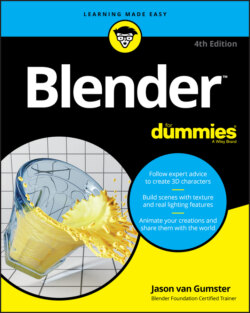Читать книгу Blender For Dummies - Jason van Gumster - Страница 23
The menu that is a pie
ОглавлениеThere’s a recent addition to Blender’s user interface that’s worth mentioning. That addition is a feature called pie menus. Technically, they existed in previous releases of Blender, but weren’t enabled by default. Contrasted with the more conventional linear, list-type menu, a pie menu lists your menu options radially around your mouse cursor. This setup has a few advantages:
Each menu item has a much larger click area. With a typical list-type menu, after you find the menu item you want, you need to precisely click a relatively small area. Having a small click area can be especially frustrating if your primary input is with a pen tablet like many artists have. With a pie menu, you need only to have your mouse cursor in the general area around your menu selection (its slice of the pie). Because you don’t need to be as precise with your mouse, you can navigate menus faster with less stress on your hand.
Menu options are easier to remember. As humans, we tend to naturally think about things spatially. It’s much easier to remember that a thing is up or left or right than to remember that it’s the sixth item in a list of things. Because the menu items are arranged in two-dimensional space, pie menus take advantage of our natural way of recalling information. Also helpful for memory is the fact that any given pie menu can only have as many as eight options.
Selecting menu items is a gestural behavior. A gestural interface relies on using mouse movement to issue a command. Pie menus are not purely gestural, but by arranging the menu items spatially, you get many of the same advantages provided by gestures. Most valuable among these advantages is the reliance on muscle memory. After working with a pie menu for an extended period of time, selecting menu items becomes nearly as fast as using hotkeys, and for essentially the same reasons. You’re no longer thinking about the direction you’re moving your mouse cursor (or which key you’re pressing). You’ve trained your hands to move in a specific way when you want to perform that task. Once you get to that point (it doesn’t take very long), you’ll find that you’re working very quickly.
Before you get too excited about pie menus, they have a couple of limitations:
Pie menus are basically limited to a maximum of eight menu items. (It’s possible to have more items, but if a pie menu has more than eight items, it becomes cluttered and the speed and memory advantages of pie menus are lessened.) Blender has a number of very long menus; therefore, they don’t all translate nicely to the pie menu model. This means that some menus will be pies and others will not. Hopefully, as development continues on Blender, these menus will migrate to being more pie-like.
Some pie menus aren’t enabled by default. A number of hotkeys are bound to pie menus already, but you can enable even more as add-ons from Preferences. (Read more about Blender add-ons in Chapter 2.)
The process of enabling additional pie menus is easy:
1 Open User Preferences (Edit ⇒ Preferences) and go to the Add-ons section.
2 On the search field on the upper right of the window, type pie menu.The add-on list should have one choice available: 3D Viewport Pie Menus.
3 Enable the pie menu add-on you want by left-clicking its check box.Additional pie menus are now enabled.
That’s it! By default, Blender automatically saves what you set in Preferences, so additional pie menus will be automatically enabled each time you start Blender.
To try out pie menus, you don’t have to actually enable any add-ons at all. With your mouse cursor in the 3D Viewport, press Ctrl+Tab to show the Mode pie menu. You should see a menu like the one in Figure 1-6. Throughout this book, you’ll see what each of these modes can be used for. The point here is to recognize pie menus and know how to use them.
FIGURE 1-6: Your first pie (menu)!
With the menu still visible, move your mouse cursor around the screen. Notice that the highlighted area of the circular slice indicator at the center of the menu points to your mouse cursor. Also notice that as you move your mouse cursor, individual menu items highlight when you enter their slice of the menu. This highlighting is how you know which menu item is currently ready to be picked. Press Esc to close the menu without selecting anything.
You can choose menu items in a pie menu in two ways:
Press, release, click: This can be considered the standard method:Press and release the hotkey that activates the menu.In this example, press and release Ctrl+Tab.Move your mouse cursor to your desired menu item’s slice.Choose that menu item by clicking anywhere within its slice.The current active slice is indicated by the circular slice indicator at the center of the menu, as well as the highlighting of each menu item as your mouse cursor enters its slice.
Press, hold, release: I think of this method as the fast way.Press and hold the hotkey that activates the menu.In this example, press and hold Ctrl+Tab.Move your mouse cursor to your desired menu item’s slice.Release the hotkey to choose that menu item.
Even without enabling any add-ons, pie menus are still used throughout Blender’s interface, so it’s worth getting used to them. One of the advantages of the add-ons is that they enable you to configure which hotkeys have an associated pie menu, so you can disable some of those pies if you’d like.
